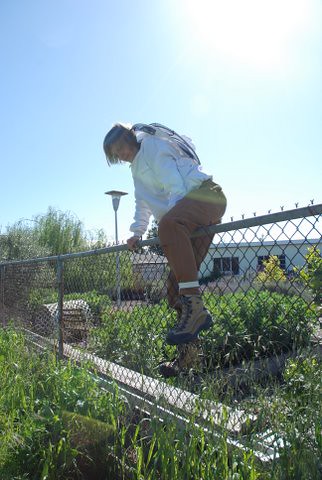Another post on writing? I know, I know, it’s a shame. Especially since so many exciting things are happening around here, like college-choosing, and climbing chain-link fences to capture swarms with intrepid beekeeping friends. But I promised to get back to you each month on my book project, so I’ll try to make this quick.
Writing in March was good. All the cutting and reassembling of last month seems to have worked, and my little Frankenstein of a chapter can breathe. It’s alive! I shared it with some very dear writing friends, and the feedback was positive. It still needs work, but I think I have the format and voice of the book worked out. Which is no small thing.
So much of this book is influenced by my experiences as a perpetual student of writing. My own struggles with learning to write have given me a different perspective on kids’ writing, one that’s very different from the traditional school model. I think that writing educators often don’t have much experience writing themselves, and they forget to use professional writers as models for how to go about the task. I’m not sure I’ve written much about this here, so I thought I’d give you a little excerpt of my work-in-progress that addresses it. This is from a section about advice from writing books and how it seemed at odds with what I was trying to do with H at the time.
“…Almost all of these books offered similar advice to beginners: If you want to get past that first barren page, you must write without considering spelling, or grammar, or the next paragraph, or what your mother might wonder, or what your sophomore English teacher might slaughter via red pen. Nearly every book on my shelf encouraged me to begin with uncensored word-spewing. In one of my favorites, Bird by Bird: Some Instructions for Writing and Life, Anne Lamott writes, “Almost all good writing begins with terrible first efforts. You need to start somewhere. Start by getting something–anything–down on paper.”
I drank down this advice like a courage-bequeathing cocktail; it was what I needed to get past the censor that I’d picked up in school, and to finally begin.
Lamott also writes this: “The first draft is the child’s draft, where you let it all pour out and then let it romp all over the place, knowing that no one is going to see it and that you can shape it later.”
This was the sad paradox that I didn’t recognize outright, but that must have nettled me on some level: H couldn’t write playful, childish drafts despite the fact that he was a child. He couldn’t romp on the page because he was burdened with the very tasks that professional writers tell adult would-be writers not to fret about. His words did not pour out; instead they got snagged and stuck as he learned to form letters in conventional shapes, facing conventional directions; as he learned to cluster those letters into words that others could read; as he began to string those words into lines others could comprehend. And he couldn’t take comfort in the fact that no one would see his work; instead he had me hovering over him, watching and worrying over what he was doing, and whether he was keeping up for his age.”
The plan for April: So now I’m on to the next chapter, another cut-and-reassemble affair, about what I learned from Lulu on the importance of developing one’s voice as a writer.
And, just because I hate to post without photos, here’s a little preview of all the promised excitement. Photo by stefaneener.

I never was any good at climbing fences. And the hiking boots didn’t help. Ouch.
(edited to add: Lest you think this photo has nothing to do with the post above, read the comments to see how smart my readers are. Everything is connected.)

Hooray! You know, climbing a fence, to challenge an unknown swarm, took a kind of childish courage too.
I’ll try to hold your ideas in mind as I’m thinking of helping my little ones write. I keep making missteps – I need a book on parenting right now!
You know, you’re right about that childish courage. Man, I love a good metaphor. Wish I’d thought of it!
And by the way, are your arms and shoulders as sore as mine are? Yesterday I thought to myself, what did I do? And then I remembered that I climbed a chain-link fence six times.
Looks like it’s going to be a wonderful book!
Thanks for the support, Lise!
Thank you for sharing that photo Patricia. It made me want to laugh (only because I can imagine myself trying to do the same thing and getting stuck). At first I thought it was an odd photo to put at the end of a post on writing but, in a way, its a visual metaphor isn’t it? Writing and climbing fences – not worrying about conventions (do women of a certain age climb fences?), struggling and trying not to get snagged. I think I’m going to have to find me a fence 😉
I just put the photo there because I like having photos with posts, and this was a funny photo. But you and stefaneener both saw the underlying metaphor that I’d missed. I completely overlooked the “snagged and stuck” connection that was right up there in my own words. And believe me, I was quite snagged and stuck on that fence!
And I like the conventions connection too. Yes, I think you ought to find a fence! I’m a bit sore for all my climbing, but it feels pretty good to know that if a chain-link fence is in my way, I can still get over it!
I like the tone of what you’ve shared from your chapter.
Tricia, I didn’t realize that there is a daredevil side to you too. I thought I read that you climbed over that fence six times; wouldn’t it be ironic if that was the magic number of setbacks kids experience before they discover their writing voice?
Hope your new bees thrive.
Thanks for the feedback on the tone of the excerpt. I plan to share plenty of the mistakes I’ve made…
I’m no daredevil; I’m a total sissy. You know that. But I was bee-less and wanted to fix that!
I don’t know how many setbacks kids will experience as they learn to write, but it’s bound to be many. So yes, it’s good to keep doing things that challenge us, to remind us how hard it is for our kids to take on new things. Even if it means getting stuck at the top of a chain-link fence.